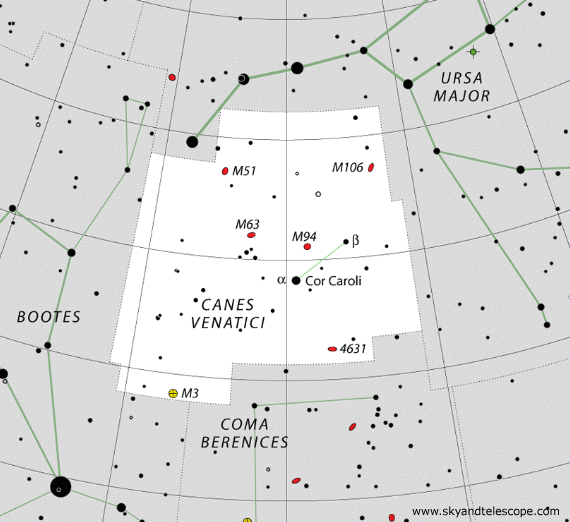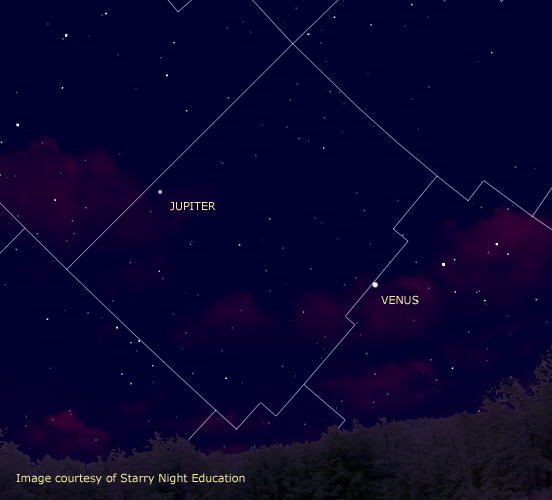Bootes Hunting Dog and Two Merging Planets
Portrayed in the sky as Canis Major and Canis Minor, Orion the Hunter is not the only one owning pets. Canes Venatici is associated with Bootes the Herdman and can be located high in the sky and below the handle of the Big Dipper. However, unlike most of the constellations we encounter, Canes does not possess and asterism except for line connecting Cor Caroli to Chara and yet it is the 38th constellation in area with 465 square degrees of sky. Getting back to Cor Caroli, it is the alpha star shine at magnitude 2.9. The majority of star names are derived from the 165 Arabic names as well as a few Greek. This sun was named by Sir Charles Scarborough, mathematician and physician to Charles II, in honour of Charles I, the king executed after the English Civil War. Cor Caroli is a double star separated by 19 arc seconds and is 110 light-years away. Chara, on the other hand, is a Greek name meaning “joy” is seen at magnitude 4.2 and is 27.5 light-years away.
Confined within the boundaries are a few wonders Messier objects. From Cor Caroli, move about three degrees north to M94. This is a magnitude 8.0 face-on spiral galaxy some 15 million light-years away. The galaxy appears to be tightly woven arms towards the centre but a brighter ring on the outside. From here move almost five degrees to the east till you find M63. AKA the Sunflower Galaxy is located 25 million light-years away and seen at magnitude 9.0. It measures the same as our Milky Way Galaxy at 100,000 km wide but sports sweeping blue galactic arms housing many pink clouds of star formation. It also has a striking yellowish core.

Leaving the Sunflower, move your scope close to six degrees north to the classic Whirlpool Galaxy. This fabulous face-on galaxy is an estimated 37 million light-years away. At first glance, you will notice another galaxy, seemingly attached to the Whirlpool. This is NGC 5196 and is most likely being distorted by the massive Whirlpool. Even at this great distance, M51 registers at magnitude 8.4 but be warned it is still a face-on and any light pollution with not help so darker skies will really help enjoy its majestic arms.
Along the bottom of Venatici’s border, we find the globular cluster M3. Referred as one of the best northern cluster other than iconic M13, M3 holds an estimated 500,000 stars including 274 known variable stars. Just under naked eye visibility, the magnitude 6.2 cluster is an estimated 90 light-years wide and some 33,900 light-years from us.
For those that are still following Comet C/2014 Q2 Lovejoy, the show continues. Our little naked eye visitor late last year is now in the constellation Ursa Minor and just misses the magnitude 2.2 star Kochab. Lovejoy is currently magnitude 8.3.

Three main planets dominate the sky this month. The first two are beacons in the western sky first seen about ten minutes after sunset. Of the two, Venus appears closer to the western horizon with Jupiter only 20 degrees away and closing. Here is where the show begins. Check out the sky every clear night this month and watch as Jupiter and Venus get closer and closer leading up to their lovely conjunction June 30 when the pair will be separated by only 20 arc minutes which will easily fit in a low power eyepiece. Check them out again on July 3 when the two appear horizontal and take on the appearance of “spooky eyes”. Jupiter will undergo a beautiful double shadow transit at 4:58 UT on the 4th. This event will now be visible for the eastern part of the country and Maritimes but favours central and western Canada.
Venus also reaches greatest eastern elongation (45 degrees) on June 6 and then over the weeks begins to sink westward. Here is and coolest time to observe and photograph Venus as it passes between the Sun and the Earth. As it does, the disk gets larger but the phase appears smaller, much like the crescent moon. Saturn has just past opposition meaning it rises in Scorpius in the east as the Sun sets in the west and will be the showpiece at summer star parties.
The Full Strawberry Moon occurs on June 2 at 16:19 UT with the new moon (lunation 1144) on the 16. And lastly, we usher in the summer solstice on June 20 16:38 UT.
Until next month, clear skies everyone.
Twitter: @astroeducator
